Nuclear Regulatory Commission
-
- Energy Research In The Oceans Maritime Reporter, May 1977 #12
The potential of the sea as a major source of energy as well as the prime route over which huge quantities of fuel are transported makes it particularly appropriate that the theme "Energy Research in the Oceans" has been selected for the first combined Society of Naval Architects and Marine Engineers Spring Meeting and Ship Technology and Research (STAR) Symposium. The SNAME Spring Meeting and STAR Symposium will be held in San Francisco, Calif., on May 25-27, 1977, with the Fairmont Hotel & Tower serving as headquarters.
The interdisciplinary nature of research in the theme area led the Society's invitation to cooperate in this precedent-setting meeting with the American Society of Civil Engineers (ASCE), Institute of Electrical and Electronic Engineers (IEEE) and Marine Technology Society (MTS).
The papers and discussions will cover current research in such diverse areas as development in marine transportation (naval architecture and machinery), offshore platforms (fixed and mobile), ocean thermal energy conversion, and LNG transportation and safety.
All segments of the maritime industry will benefit from the indepth examination of advances in technology in these fields which are vital to the orderly development of energy sources and efficient water transportation.
Technical Program The technical program includes the presentation of 34 papers and four round table discussions. The schedule is as follows: SESSION T1 — May 25, A.M. — Marine Transportation (Machinery) Tl-1 "Updating an Ancient Art —Research and Development Toward Modern Wind Powered Cargo Ships" by W.L. Warner and M.M. Kossa.
SYNOPSIS — A thorough overview of research in the aerodynamics of sails and the optimization of novel rigs for sailing cargo ships is provided. Theoretical and practical limits in sailing ship size are discussed, criteria are offered for the selection of the rig and hydrodynamic characteristics of sailing ship hulls are covered. Conceptual designs of cargo ships in the "handy" 17,000 to 25,000-dwt range are presented.
Tl-2 "Improvements in Part Load Performance of Marine Steam Turbines" by B. Siegel.
SYNOPSIS — Increases in fuel prices have modified the economics of ship operation so part-load performance of steam plants has become increasingly important.
Various changes, including modification of valving, variable steam pressure, cruising turbines, number of turbine stages, use of bypass, condenser vacuum and number of feed heaters, are discussed and evaluated for their impact on part-load economy for both existing and new design plants.
Tl-3 "Efficiency Considerations for Future Marine Gas Turbines" by G.J. Baham and H.D. Marron.
SYNOPSIS — Navy programs for development of advanced gas turbines for marine use based on modifications and adaptations of aircraft gas turbines are reviewed.
Means for improvement in efficiency by use of regeneration, steam-water injection, closed Brayton cycle, waste heat and bottoming cycles are discussed.
A limited economic study evaluates the effectiveness of each cycle when applied to the DD 963.
SESSION T2 — May 25, A.M. — Offshore Fixed Platforms T2-1 "Fixed Offshore Steel and Concrete Platforms" by E.M.Q.
Roren, I.J. Foss and O. Furnes.
SYNOPSIS—This paper describes the major features of the recent engineering advances that have supported the development of the fixed offshore platform.
T2-2 "Maximum Wave Loadings on Fixed and Floating Platforms" by F.H. Sellars.
SYNOPSIS — The hydrodynamic forces acting on fixed and floating platforms are reviewed and experience with determining maximum wave loads is discussed.
The effect of wave non-linearities is covered. Field data for high wave conditions are summarized and is used in several examples to estimate design wave conditions and to calculate maximum wave forces.
T2-3 "Soil-Structure Interaction in the Design of Offshore Platforms" by L.C. Reese.
SYNOPSIS—One of the more crucial technical challenges relating to the safety of an offshore platform is that due to the soil/ structure interaction. This paper discusses laterally loaded pile foundations and other soil/structure interaction problems important to the design of offshore platforms, reviews the state-ofthe- art, and provides indications for future developments.
SESSION T3 — May 25, P.M. — Marine Transportation (Machinery) T3-1 "Marine Fuels—Their Future and Use Aboard Ship" by F.X. Critelli.
SYNOPSIS — The most probable course of events (type, availability, price) in marine bunkers for the forseeable future is discussed.
Various projects underway by the U.S. Maritime Administration relating to improving fuel consumption aboard ship are described.
These projects address such areas as combustion improvement, advanced marine boiler/burner design, degraded fuels, propulsion systems and advanced powerplants.
T3-2 "Nuclear Energy—A Viable Alternative" by Z. Levine, R.W. Dickinson and A.O. Winall.
SYNOPSIS—The viability of nuclear energy as an alternative to conventional energy sources (i.e.
fossil fuels) for the propulsion of merchant ships is examined. Critical factors are explored in detail which support the conclusion that nuclear propulsion is a workable solution for solving the nation's energy problems.
T3-3 "Maritime Applications of an Advanced Gas-Cooled Reactor Propulsion System" by R.E.
Thompson and R.T. Miller.
SYNOPSIS — A lightweight marine gas-cooled reactor which is an outgrowth of the nuclear rocket program is described. A study showing the installation of this plant in place of gas turbines in a high-performance surface ship and a cargo liner is presented. A discussion is included of the effects of the change in powerplant on hull stress, machinery box size, first cost and operating cost.
SESSION T4 —May 25, P.M.— Offshore Fixed Platforms T4-1 "Dynamic Analysis of Gravity Platforms Subjected to Random Wave Excitation" by T. Moan, K. Syvertsen and S.
Haver.
SYNOPSIS — Techniques for the analysis of the dynamic motions of offshore gravity structures have now been developed to the point where they are useful engineering tools. This paper reviews these techniques and indicates the important dynamic motions for gravity platforms in random seas.
T4-2 "A Method for Static Analysis of Pile-Foundation Superstructure Interaction in Fixed Offshore Platforms" by M.F. Metcalf and D.B. Gerdes.
SYNOPSIS — This paper offers a method for solving the static interaction analysis problem in a way that improves the interface model and reduces the cost of an analysis. By viewing the elastic superstructure as a single linear "super element," the non-linear character of the interface is confined to a system composed of non-linear foundation components, an elastic element connecting them and a set of equivalent loads. The solution of this simplified system is obtained by an efficient numerical technique, and represents a set of boundary conditions on the remaining linear superstructure.
T4-3 "Structural Damage Detection by Measurement of Dynamic Response" by J.K. Vandiver.
SYNOPSIS — Damage to an offshore structure when below the waterline is difficult to determine by inspection. Recently, dynamic techniques have evolved to sense the presence of major structural damage in below-waterline structural elements. This paper describes experiments toward the evaluation of detecting structural damage by these techniques.
RT-1 Round-Table Discussion — All authors from Sessions T1 and T3.
RT-2 Round-Table Discussion — All authors from Sessions T2 and T4.
SESSION T5 — May 26, A.M. — Ocean Thermal Energy Conversion (OTEC) T5-1 "OTEC—A Survey of the State of the Art" by H.E. Sheets.
SYNOPSIS — The OTEC concept is discussed, with emphasis on results of major studies, demonstrating the adequacy of existing state-of-practice in energy production.
Emphasis is on system components, economics and geopolitical aspects, with particular attention to heat exchanger development requirements.
T5-2 "Conceptual Design of OTEC Platforms" by E.H. Harlow, R. Cohen and H. Skowbo.
SYNOPSIS—The status of OTEC conceptual designs suitable for operation in areas of the tropical and subtropical oceans is reviewed.
Characteristics of OTEC platforms, including cost, mooring, maintenance, motions and habitability are compared for proposed designs. Potential contribution to future energy needs is projected.
T5-3 "Prospects for OTEC Energy Utilization" by J.E. Snyder and R.H. Douglass Jr.
SYNOPSIS — Direct electrical transmission and energy-intensive product manufacturing on site are two approaches to OTEC energy utilization. Relative merit considerations of transmission versus aluminum smelting and ammonia production facility designs include cost, environmental impact, safety, sea motions and demand for product.
T5-4 "Engineering Aspects of OTEC Systems" by L.C. Trimble.
SYNOPSIS—The plant described is a closed-loop thermodynamic cycle with ammonia as the working fluid. Considered are the engineering aspects of the system components, naval architecture of the floating spar-type platform, and economics of energy production and utilization.
SESSION T6 —May 26, A.M.— Offshore Mobile Platforms T6-1 "Downtime Evaluation for Operations from Floating Vessels in Waves" by B.G. Burke.
SYNOPSIS — Methods are described for evaluating downtime for a variety of in-ocean operations from floating vessels in waves. Downtime estimates are determined from the motion characteristics of the vessel in waves, an evaluation of motion parameters and limits directly associated with operations to be performed, and wave conditions to be encountered. Results provide quantitative measures for evaluating feasibility of operations, relative benefits of alternative vessels, and the effectiveness of special equipment and procedures for increasing operating time.
T6-2 "Time Domain Simulation of Semisubmersible Platform Motion with Application to the Tension- Leg Platform" by J.R. Paulling Jr.
SYNOPSIS — A numerical timedomain solution of the equations of motion for a floating semisubmersible stable platform offers the possibility of more accurate estimates of vessel motion response in severe sea conditions than are possible by the linear f r e q u e n c y domain technique.
Some example calculations are described in which the technique is applied to the analysis of motions and anchoring forces for a tension- leg stable platform.
T6-3 "Theoretical Analysis of Single-Point Mooring Behavior" by D.G. Owen and B.T. Linfoot.
SYNOPSIS — The detailed development of mathematical models for determining the dynamic behavior of single-point mooring installations is discussed. Computer results obtained with a simplified five-degree of freedom mathematical model of a single-point mooring system showing the correlation that is established by the results of a limited physical model testing program are presented.
T6-4 "Design Considerations of the U.S. Nuclear Regulatory Commission for the Construction of Nuclear Power Generating Stations in the Ocean" by R.A. Birkel and R.J. Bosnak.
SYNOPSIS — Introductory material describing a typical landbased nuclear powerplant is followed by a discussion of the current projects now under review by the Nuclear Regulatory Commission bearing on the use of nuclear power g e n e r a t i ng plants in the ocean. Design verification through scale model testing and analytical modeling for ocean applications of nuclear power generating plants is discussed.
The current NRC position on the respective role of scale model testing and analytical modeling is presented.
SESSION T7 —May 26, P.M.— Ocean Thermal Energy Conversion (OTEC) T7-1 "Theoretical Evaluation of the Seakeeping Performance of Five Candidate OTEC Platforms" by R.A. Barr and J.F. O'Dea.
SYNOPSIS — A Theoretical approach is presented and applied to five platform types—ship, submarine, vertical column stabilized semisubmersible, disc and axisymmetric spar. Motions and cold water pipe bending moment distributions are investigated.
T7-2 "Studies of Biofouling in OTEC Plants" by F.C. Munchmeyer, J.G. Fetkovich, G.N. Grannemann, L.M. Mahalingam and D.L. Meier.
SYNOPSIS—An experiment program leading to an understanding of the effects of biofouling on the heat transfer characteristics of tubes in an ocean environment is presented in detail. The test apparatus is described, thermodynamic equations are given, initial laboratory tests and preliminary data from in-situ operational testing are discussed.
T7-3 "The Ocean Food and Energy.
Farm Project" by H.A.
Wilcox.
SYNOPSIS — A project is described which will supply all the food, energy and petrochemicallike material requirements for a small city. Giant kelp farms in the ocean using nutrient-rich deep waters brought to the warm surface are thoroughly reviewed including farm concept, kelp biology, methane production, upwelling and test farms.
SESSION T8 —May 26, P.M.— Offshore Mobile Platforms T8-1 " E v a l u a t i n g S t a b i l i ty Characteristics of Self-floating Offshore Towers" by M.F. Metcalf and M.W. Praught.
SYNOPSIS — Traditional techniques of evaluating stability during upending have been supplemented by new procedures involving i n t e r a c t i v e computer simulation techniques. Stability considerations developed in the design process are compared with regular guidelines and standards in order to point out the extent to which designers today are developing rational stability criteria.
T8-2 "Nonmetallic Materials for Offshore Engineering" by J.D.
Stachiw.
SYNOPSIS — Nonmetallic materials, in particular concrete and glass materials, have many potential offshore applications. Research required on properties of these materials is described.
T8-3 "Current Advancement in Automatic Station-Keeping" by C.R. Schaeffner and T.F. Dixon.
SYNOPSIS—A description is given of the automatic station-keeping system p r o p o s e d for the Glomar-40 Class drillship, consisting of conventional mooring and dynamic positioning based on an inertial reference system. A discussion of the computer simulation showing the value of the inertial reference unit is included.
RT-3 Round-Table Discussion — All authors from Sessions T5 and T7.
RT-4 Round-Table Discussion — All authors from Sessions T6 and T8.
SESSION T9 — May 27, A.M. — LNG T9-1 "A Review of the IMCO Code for Gas Ships" by R.J.
Lakey, J.W. Kime and T.R.
Dickey.
SYNOPSIS — T h e paper reviews the background of the development of some of the more important requirements of the IMCO Code for Liquefied Gas Ships, such as those for cargo tanks, relief valves and damage stability.
It also explains the actions of the Coast Guard in implementing the Code.
T9-2 "LNG Ship Safety Enhanced by Research and Development" by J.L. Howard and R.
Kvamsdal.
SYNOPSIS—The authors provide a brief history of the analytical and research work that formed the basis for the Kvaerner-Moss spherical tank design. They go on to describe in more detail the correlation between the analysis and the recent experimental results obtained testing the larger aluminum tanks. Data concerning recent LNG ship collision studies and a discussion of the importance of total ship safety in the as-built condition are included.
T9-3 "The LNG Ship in a Changing Energy Environment" by W D. Thomas.
SYNOPSIS — T h e author's view on the changing worldwide energy situation and the effects of those changes on future LNG ships is presented. A review of shipboard LNG containment systems which are being offered today or have been constructed in the past is also included. The author discusses various design parameters such as speed and power, fuel oil prices, ship size, tank type and size, liquefaction equipment and their effects on the cost of delivery of LNG by ship.
T9-4 "U.S. Offshore LNG Terminals: If and When" by H.S.
Marcus and J.H. Larson.
SYNOPSIS—The authors discuss the many factors, economic and non-economic, that will influence the possible use of offshore LNG terminals in the United States.
Also described is the conceptual design of a computer model that will permit the economic evaluation of alternative LNG logistical systems. Hypotheses are offered concerning the future use of U.S.
LNG terminals.
SESSION T10—May 27, A.M.— Marine T r a n s p o r t a t i o n (Naval Architecture) T10-1 "A Look at Future Materials/ Structural Design Interfaces" by P.H. Francis, J. Lankford Jr. and T.S. Cook SYNOPSIS — The paper offers a thorough discussion of the performance characteristics of conventional and advanced steels available for maritime structures.
The authors outline their perspectives as to the current state of materials t e c h n o l o g y with specific reference to steel and weldment metallurgical characteristics, corrosion susceptibility, fracture performance, load rate effects and structural fatigue.
Identification is made of several problem areas that must yet be solved.
T10-2 "Design Concepts f o r Efficient Use of Prestressed Concrete Ship Hulls" by B.C. Gerwick Jr.
SYNOPSIS—Recent dramatic advances in the utilization of prestressed concrete for sea structures in the North Sea and off Australia have awakened interest in concrete ship hulls for use as floating platforms, barges and special purpose transport vessels.
This paper briefly reviews the history of concrete ships. Illustrations are given of structural details which optimize the advantages of concrete, problem areas are discussed and construction methods are briefly covered.
T10-3 "Improving Fuel Efficiency of Existing Tankers" by P.A. Ellingsen, P.D. Fitzgerald, J.E. Goulden, W.C. Squillario and R.C. Uhlin.
SYNOPSIS — This timely paper identifies f o u r main areas in which steps can be initiated to achieve improved fuel efficiency in existing tankers. They are the powerplant and its auxiliaries, the propeller, hull resistance, and navigation and steering. Specific items discussed in each area range from simple operational procedure changes to major modifications.
T10-4 "Fouling Control Means Fuel Savings for the U.S. Navy" by H.S. Preiser, G.S. Bohlander and C.P. Cologer.
SYNOPSIS — Based upon a detailed study of the subject by the Navy, the paper reviews the characteristics of f o u l i n g and describes current underwater hull cleaning and inspection methods.
It discusses the i n t e r a c t i o n s among fuel consumption, fouling, and the compatibility of underwater cleaning methods with the antifouling paint coating on a hull.
Special Activities The following social and special activities have been arranged for members and guests attending the 1977 Spring Meeting: AUTHORS' BREAKFAST — The authors' breakfast will be held each day of the meeting in the Pavilion Room at 7:30 a.m.
for the authors on the current day's program.
ORIENTATION BREAKFAST will be held in the Gold Room at 8:00 a.m. on Wednesday, May 25.
This breakfast is for registrants, spouses and guests. It will provide an opportunity to learn more about the meeting program and to answer questions regarding San Francisco. The president of the Society, Robert T. Young, will open the 1977 Spring Meeting at this time with his welcome to all attendees.
WINE COUNTRY TOUR—An all-day tour, starting at 9:30 a.m.
on Wednesday, of California's famous Napa Valley, producer of classic wines since 1858. Visits to at least two wineries, wine tasting and a call at picturesque Yountville, founded in 1870.
PRESIDENT'S RECEPTION— Society president, Mr. Young, will be host to all registrants and their spouses at this traditional social event. It will be held at 6:00 p.m.
on Wednesday in the Roof Garden and Pavilion Room.
OPTIONAL TOURS have been arranged for Thursday, starting at 9:00 a.m. During registration hours a tour representative will be available to accommodate those wishing to take tours of San Francisco Bay Area, such as Muir Woods and San Francisco City Scenic Tour.
GOLDEN GATE LUNCHEON will be held in the Gold Room on Thursday, starting at 11:30 a.m.
Ladies and guests may join the registrants. Luncheon will feature the presentation of Society citations and an address by Congressman Paul N. McCIoskey Jr., member of the House Committee on Merchant Marine and Fisheries.
SAN FRANCISCO BAY CRUISE will be held on Friday, starting at noon. Board buses at the Fairmont Hotel for transportation to the 550-passenger Harbor Emperor for a two-hour guided tour and see some of San Francisco's most famous landmarks, including Golden Gate Bridge and Alcatraz Island.
FAREWELL BALL (dress is optional) will be held in the Vanderbilt and Terrace Rooms (general reception) and Grand Ball Room (banquet) on Friday, starting at 7:00 p.m. The grand finale of the week's activities will be a banquet with music by Ernie Heckscher's internationally famous dance orchestra.
The Host Section The Northern California Section of SNAME has planned and will host this Spring Meeting.
The officers of this Section are: William B. Swan, chairman; Murray M. Montgomery, vice chairman, and David C. Pritchard, secretary/treasurer.
The special committees and their chairmen for the Spring Meeting are: 1977 Spring Meeting Steering Committee—Arthur J. Haskell, Technical Program— Nathan Sonenshein, Social Affairs —Richard M. Engelbert, Registration— W. Graham Fraser, Fund Raising—Morris Guralnick, Hotel Arrangements—Wilson Stackhouse and Robert Lamb, Finance —Henry Kozlowski, and Publicity —Eugene K. Pentimonti.
-
- PRI Fuel Treatment Helps Meet Emissions Challeng es Maritime Reporter, Oct 2001 #47
component overhaul times. PRI-D has endorsements by engine manufacturers, has been extensively tested for safety and effectiveness under Nuclear Regulatory Commission (NRC) guidelines for use in standby diesel powered generators at nuclear power facilities. PRI-D is the choice of many wholesale fuel distri
-
- Chesapeake Section Members Visit Naval Academy —Paper On Floating Nuclear Power Plants Presented Maritime Reporter, Jul 1978 #42
and the LHA-l-Class of Amphibious Assault Ships meet the stringent U.S. Navy survivability requirements. A former member of the U.S. Nuclear Regulatory Commission, Mr. Amir has worked toward improving the structural safety of land-based and floating nuclear power plants. Mr. Simmons attended
-
 )
April 2024 - Maritime Reporter and Engineering News page: 43
)
April 2024 - Maritime Reporter and Engineering News page: 43“The industry is an ecosystem which includes owners, managers, mariners, shipyards, equipment makers, designers, research institutes and class societies: all of them are crucial,” – Eero Lehtovaara, Head of Regulatory & Public Affairs, ABB Marine & Ports All images courtesy ABB Marine and Ports provi
-
 )
April 2024 - Maritime Reporter and Engineering News page: 42
)
April 2024 - Maritime Reporter and Engineering News page: 42OPINION: The Final Word Seeing the Ship as a System Shipping must engage with the decarbonization realities that lie ahead by changing the way it crafts maritime legislation to re? ect its place in the interconnected, interdependent world economy, said Eero Lehtovaara, ABB Marine & Ports. ABB Marine &
-
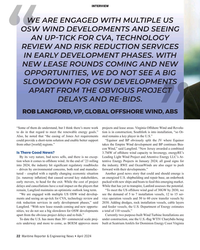 )
April 2024 - Maritime Reporter and Engineering News page: 22
)
April 2024 - Maritime Reporter and Engineering News page: 22INTERVIEW WE ARE ENGAGED WITH MULTIPLE US OSW WIND DEVELOPMENTS AND SEEING AN UP-TICK FOR CVA, TECHNOLOGY REVIEW AND RISK REDUCTION SERVICES IN EARLY DEVELOPMENT PHASES. WITH NEW LEASE ROUNDS COMING AND NEW OPPORTUNITIES, WE DO NOT SEE A BIG SLOWDOWN FOR OSW DEVELOPMENTS APART FROM THE OBVIOUS
-
 )
April 2024 - Maritime Reporter and Engineering News page: 21
)
April 2024 - Maritime Reporter and Engineering News page: 21ROB LANGFORD, VP, GLOBAL OFFSHORE WIND ob Langford has worked in the offshore industry ABS. “We are growing and evolving our services across all for more than three decades, ‘cutting his teeth’ offshore infrastructure along with our continued support to the in a UK design ? rm working in the North Sea
-
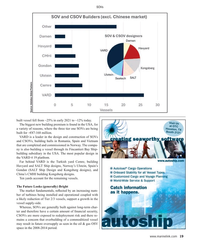 )
April 2024 - Maritime Reporter and Engineering News page: 19
)
April 2024 - Maritime Reporter and Engineering News page: 19SOVs Source: Intelatus Global Partners built vessel fell from ~25% in early 2021 to ~12% today. Visit Us The biggest new building premium is found in the USA, for at OTC Houston, TX a variety of reasons, where the three tier one SOVs are being Booth 2121 built for ~€87-168 million. VARD is a leader in
-
 )
April 2024 - Maritime Reporter and Engineering News page: 18
)
April 2024 - Maritime Reporter and Engineering News page: 18MARKETS & gas activity returns, we anticipate that supply of the vessels The Question of Emissions to offshore wind projects will reduce, driving demand for ad- Given that SOVs and CSOVs operate in a segment target- ditional CSOVs. ing reduced emissions, and many operate in the North Eu- Outside of China
-
 )
April 2024 - Maritime Reporter and Engineering News page: 16
)
April 2024 - Maritime Reporter and Engineering News page: 16MARKETS SOVs – Analyzing Current, Future Demand Drivers By Philip Lewis, Director of Research, Intelatus © Björn Wylezich/AdobeStock t a high-level, there are three solutions to transferring Lower day rate CTVs are often used for daily transfer of technicians from shore bases to offshore wind farms
-
 )
April 2024 - Maritime Reporter and Engineering News page: 14
)
April 2024 - Maritime Reporter and Engineering News page: 14Book Review Approach to Meeting Underwater Radiated Noise Limits Def ned By Raymond Fischer uantitative underwater radiated noise limits will construction inspections, 5) possible training with respect to be developed shortly by IMO, and/or countries salient design/construction essentials, 6) compliance
-
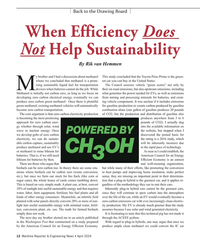 )
April 2024 - Maritime Reporter and Engineering News page: 12
)
April 2024 - Maritime Reporter and Engineering News page: 12from 3 to 6 approach for zero carbon ener- pounds of CO2). I actually dug gy whether through solar, wind into the available information on wave or nuclear energy. Once the website, but stopped when I we develop gobs of zero carbon discovered the posted basis for electricity, we can do sustain- the
-
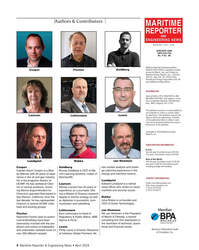 )
April 2024 - Maritime Reporter and Engineering News page: 4
)
April 2024 - Maritime Reporter and Engineering News page: 4Authors & Contributors MARITIME REPORTER AND ENGINEERING NEWS M A R I N E L I N K . C O M ISSN-0025-3448 USPS-016-750 No. 4 Vol. 86 Maritime Reporter/Engineering News (ISSN # 0025-3448) is published monthly Cooper Fischer Goldberg except for March, July, and October by Maritime Activity Reports, Inc.
-
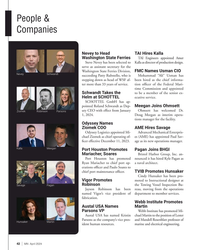 )
April 2024 - Marine News page: 42
)
April 2024 - Marine News page: 42People & Companies Nevey to Head TAI Hires Kalla Washington State Ferries TAI Engineers appointed Amer Steve Nevey has been selected to Kalla as director of production design. serve as assistant secretary for the FMC Names Usman CIO Washington State Ferries Division, Nevey Schwandt succeeding Patty
-
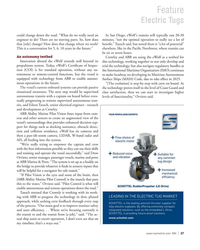 )
April 2024 - Marine News page: 37
)
April 2024 - Marine News page: 37Feature Electric Tugs could change down the road. “What do we really need an In San Diego, eWolf’s transits will typically run 20-30 engineer to do? There are no moving parts. So, how does minutes, “not the optimal operation to really see a lot of that [role] change? How does that change where we work?
-
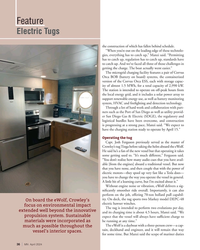 )
April 2024 - Marine News page: 36
)
April 2024 - Marine News page: 36Feature Electric Tugs the construction of which has fallen behind schedule. “When you’re out on the leading edge of these technolo- gies, everything has to catch up,” Manzi said. “Permitting has to catch up, regulation has to catch up, standards have to catch up. And we’ve faced all three of those challenge
-
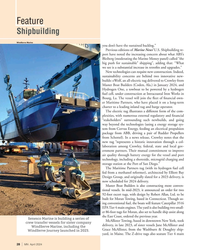 )
April 2024 - Marine News page: 28
)
April 2024 - Marine News page: 28Feature Shipbuilding WindServe Marine you don’t have the sustained backlog.” Previous editions of Marine News’ U.S. Shipbuilding re- port have noted the increasing concern about what ABS’s Bleiberg (moderating the Marine Money panel) called “the big push for sustainable” shipping”, adding that: “What we
-
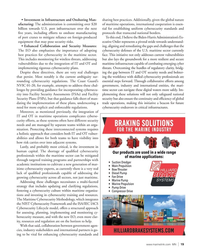 )
April 2024 - Marine News page: 19
)
April 2024 - Marine News page: 19• Investment in Infrastructure and Onshoring Man- sharing best practices. Additionally, given the global nature ufacturing: The administration is committing over $20 of maritime operations, international cooperation is essen- billion towards U.S. port infrastructure over the next tial for establishing
-
 )
April 2024 - Marine News page: 13
)
April 2024 - Marine News page: 13Q&A We’ve still got some work to do. Despite the new guid- Looking across the industry, what are some ance, we are seeing differences in the way that the Coast other important regulatory issues that AWO is Guard is applying crewing and life-saving requirements to currently paying attention to? ATBs from
-
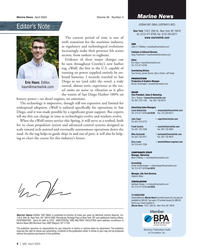 )
April 2024 - Marine News page: 4
)
April 2024 - Marine News page: 4Marine News April 2024 Volume 35 Number 4 Marine News (ISSN#1087-3864) (USPS#013-952) Editor’s Note New York: 118 E. 25th St., New York, NY 10010 tel: (212) 477-6700; fax: (212) 254-6271 www.marinelink.com The current period of time is one of swift transition for the maritime industry, CEO as regulatory
-
 )
February 2024 - Maritime Reporter and Engineering News page: 44
)
February 2024 - Maritime Reporter and Engineering News page: 44Tech Files Latest Products & Technologies MarineShaft Yanmar Hydrogen MarineShaft specializes in urgent re- Fuel Cell AIP pair/replacement of damaged rudder and Yanmar Power Technology Co., Ltd. propeller equipment along with many (Yanmar PT), a subsidiary of Yanmar on-site repair services. MarineShaft
-
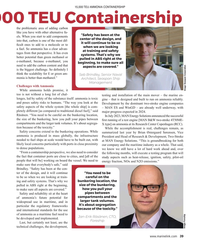 )
February 2024 - Maritime Reporter and Engineering News page: 39
)
February 2024 - Maritime Reporter and Engineering News page: 3915,000 TEU AMMONIA CONTAINERSHIP 000 TEU Containership the problematic area of adding carbon like you have with other alternative fu- “Safety has been at the els. When you start to add components center of the design, and into that, carbon is one of the most dif- it will continue to be so ? cult ones
-
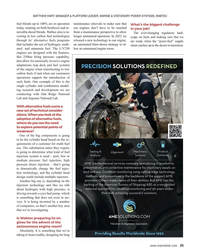 )
February 2024 - Maritime Reporter and Engineering News page: 25
)
February 2024 - Maritime Reporter and Engineering News page: 25MATTHEW HART, MANAGER & PLATFORM LEADER, MARINE & STATIONARY POWER SYSTEMS, WABTEC fuel blends up to 100% are in operation maintenance intervals to make sure that What’s the biggest challenge today, running on both biodiesel and re- our engines don’t have to be touched in your job? newable diesel blends.
-
 )
February 2024 - Maritime Reporter and Engineering News page: 22
)
February 2024 - Maritime Reporter and Engineering News page: 22R&D MATT HART Matt Hart, Manager & Platform Leader, Marine & Stationary Power Systems, Wabtec, offers insights on how the megatrends of decarbonization, energy transition and autonomy all inspire Image courtesy Wabtec and impact the marine power solutions from Wabtec. By Greg Trauthwein Matt, to start
-
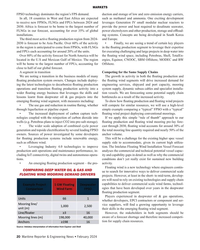 )
February 2024 - Maritime Reporter and Engineering News page: 20
)
February 2024 - Maritime Reporter and Engineering News page: 20such as methanol and ammonia. One exciting development to receive new FPSOs, FLNGs and FPUs between 2024 and leverages Generation IV small modular nuclear reactors to 2030. Africa is forecast to be home to the largest number of provide the power and heat required to desalinate seawater, FLNGs in our
-
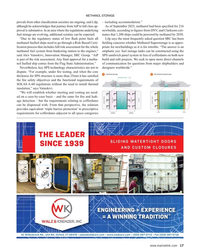 )
February 2024 - Maritime Reporter and Engineering News page: 17
)
February 2024 - Maritime Reporter and Engineering News page: 17METHANOL STORAGE provals from other classi? cation societies are ongoing, said Lilp, – including accommodation.” although he acknowledges that journey from AiP to full class ap- As of September 2023, methanol had been speci? ed for 216 proval is substantive. In an area where the regulations underlying
-
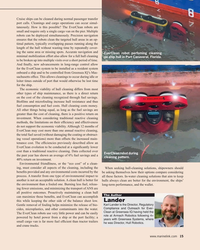 )
February 2024 - Maritime Reporter and Engineering News page: 15
)
February 2024 - Maritime Reporter and Engineering News page: 15Cruise ships can be cleaned during normal passenger transfer port calls. Cleanings and cargo operations can occur simul- taneously. How is this possible? The EverClean robots are small and require only a single cargo van on the pier. Multiple robots can be deployed simultaneously. Precision navigation
